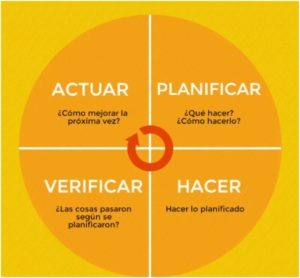The Plan Do Check Act Cycle, or PDCA, is a methodology of continuous improvement whose name is derived from the acronym Plan, Do, Check, Act (PHVA).
It also sis known as the continuous improvement circle or Deming Circle, in reference to its author, William Edwards Deming.
With these steps they translate: Plan, Do, Check and Act can make improvements really easy, and best of all, when you're done, you go back to planning.

Objectives:
- The aim is to reduce failures and progressively increase the efficiency and effectiveness of the company's processes.
- In addition, problem solving, anticipating and eliminating potential adversities.
The four stages mentioned above: Plan, Do, Check and Act, are applied on a cyclical basis. In other words, once the action stage is over, it is back to planning.
This re-evaluation makes it possible to The new technology can detect and integrate new improvements and is of great benefit to companies and organisations, irrespective of the field in which they operate.
What are the stages of the PDCA cycle?
The Do Check Act Plan is a cycle composed of four stages:
- Planning phase
During this phase, all those activities and processes that are susceptible to improvement are detected, and to this end, the following are determined achievable objectives.
In this process, it is essential to gather feedback from the workers, as they are the first ones in direct contact with the production chain; it is also important to gather the customer's impressions, etc.
- Action phase
Once the activities that can be improved have been identified, the proposed improvements have to be implemented.
For this purpose, small pilot tests are most often carried out to avoid failures arising from the application of new procedures on a large scale, since, These may not take into account all the necessary aspects.
- Verification phase
Pilot testing allows results to be collected and analysed, how they could be improved and their applicability on a larger scale to be studied. If they do not meet the expectations and objectives set, it is time to modify them so that they do.
- Action phase
When the improvement is implemented and a reasonable time has passed, the results are verified and compared with previous performance and procedures, it is time to make decisions.
When the results are satisfactory, the improvement is implemented, otherwise we return to the first stage, carrying out consecutive iterations.
Now that you know Deming's circle, reflect and apply it:
- Find a problem to solve and apply the circle
After the question and before think of yourself.
You can also consult other Related TIPs.
Learn more about mentoring by downloading this free EBOOK.
Do you want to help an entrepreneur by sharing your experience as a MENTOR? get accredited now.
Are you an entrepreneur? If you need support to boost your business, apply now for your mentor.








